The best ion measurement method depends on your sample type and required accuracy. For simple aqueous solutions, you'll want to use the direct method, which offers quick results with minimal preparation. If you're dealing with high ionic strength samples, opt for the dilution method to reduce interference. The matrix match method works well for complex but consistent samples, while the known addition method delivers superior accuracy for challenging matrices like food and waste samples. Each technique requires proper calibration, sample preparation, and electrode maintenance to guarantee reliable results. Understanding these methods' specific applications will help you make the right choice for your analysis needs.
Understanding Ion Measurement Basics
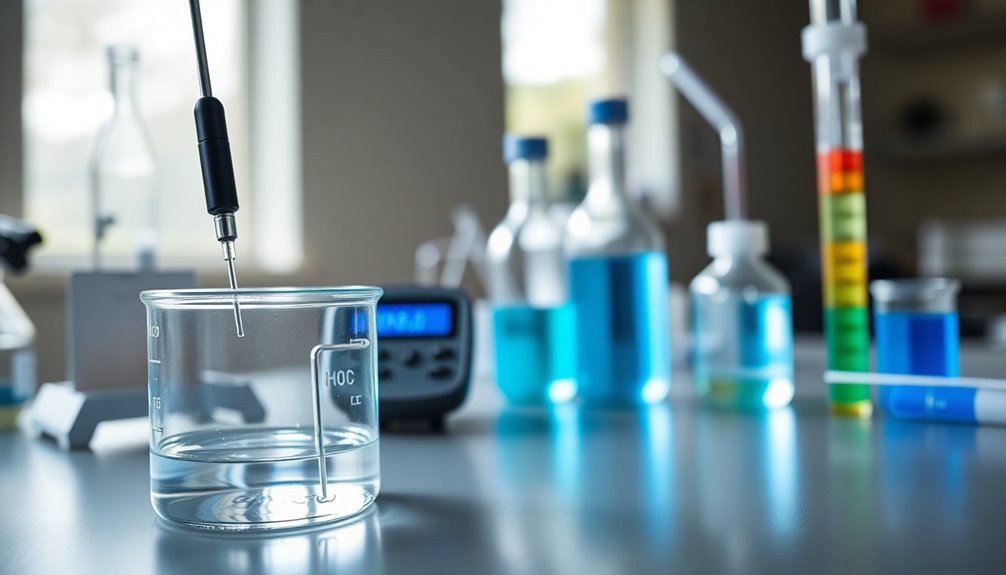
Ion measurement stands at the core of modern analytical chemistry. When you're working with ion-selective electrodes (ISEs), you'll need to understand the Nernst equation, which forms the theoretical foundation for how these devices measure ion activity rather than concentration. This distinction becomes particularly valuable when you're analyzing biological and medical samples.
You'll find that ISEs operate effectively within specific parameters. The temperature range typically spans from 0°C to 50 or 80°C, with most standard measurements taken at 20, 25, or 37°C. These electrodes can measure ion concentrations from 10^-1 to 10^-6 mol/L, giving you considerable flexibility across different applications. These versatile tools are extensively used in chemical and pharmaceutical industries for various analytical purposes. Recent studies have shown that ATR-FTIR spectroscopy provides highly accurate measurements for ion concentrations between 0.5-2 M.
However, you'll need to maintain moderate pH levels, avoiding extreme acidic or alkaline conditions that could compromise your results.
For accurate measurements, you must consider the ionic strength of your solutions. You'll often need to add an ionic strength adjuster (ISA) to maintain a consistent ionic background.
Additionally, you'll want to use conditioning solutions to preserve the equilibrium of measuring ions in the membrane, ensuring your measurements remain reliable and reproducible.
Direct Method Applications
You'll find the direct method particularly effective when measuring ions in natural water samples and pure solutions due to their typically dilute nature.
The real-time analysis capabilities allow for immediate results without complex sample preparation steps.
For natural water analysis, you can simply add ISA to your samples and standards before following standard calibration procedures with your ISE meter. High ionic backgrounds must be properly matched between samples and calibration standards for accurate results.
When testing pure solutions, you'll benefit from the method's simplicity and quick results while maintaining good accuracy since these samples have minimal interfering ions.
Natural Water Analysis
For accurate analysis of natural water samples, direct measurement methods provide efficient solutions when working with dilute, aqueous specimens. You'll find that ion selective electrodes (ISEs) can directly measure specific ions like ammonia, fluoride, and calcium without extensive sample preparation. Sequential treatment processes are crucial for preparing ultra-pure water used in these analyses. Traditional detection methods like volumetric analysis remain effective particularly for neutral to alkaline water samples.
| Method | Key Advantages | Detection Range |
|---|---|---|
| Direct ISE | Minimal preparation, real-time results | ppm to high range |
| Ion Chromatography | Multiple ions simultaneously, high accuracy | Sub-0.1 ppm |
| Spectrophotometric | Specific for certain ions, automated options | Low to mid ppm |
| Titrations | Large sample volumes, regulatory compliance | ppm levels |
| Potentiometric | Automated endpoints, reduced human error | ppm to high range |
You'll want to take into account that ion chromatography offers excellent sensitivity for common anions and cations, reaching sub-0.1 ppm levels with small sample volumes. For specific ions like iron and silica, spectrophotometric methods provide highly selective analysis with minimal interference. When you're working in regulated environments, titrations remain popular, especially with potentiometric end-point detection, which reduces human variability. These methods require proper calibration with standards prepared similarly to your samples, and you should watch for potential interference from high ionic strength or organic compounds.
Testing Pure Solutions
The direct method stands out as the preferred approach when testing pure solutions, especially for dilute aqueous samples and treated wastewater effluents.
You'll find this method particularly effective when working with natural waters, potable waters, and samples with low ionic strength backgrounds that match your calibration standards.
To implement this method, you'll need to add ISA solution to both your standards and samples. Ion-selective electrodes respond specifically to individual ion types, ensuring accurate measurements.
Start by calibrating with standards, then proceed directly to testing your samples. You should maintain gentle stirring throughout and remember to rinse your electrodes between measurements.
It's essential that you match the ionic strength between your samples and standards for accurate results.
You'll appreciate the direct method's advantages: it's the quickest and simplest approach for dilute samples, offering high precision when properly executed.
However, you must keep certain limitations in mind. Don't use this method for high ionic strength samples, and be aware that differences in conductivity can affect your results.
You'll need to maintain precise calibration and regularly verify your electrode's performance. Additionally, you may need to take steps to prevent carbon dioxide absorption, which can interfere with your measurements.
When To Use Dilution
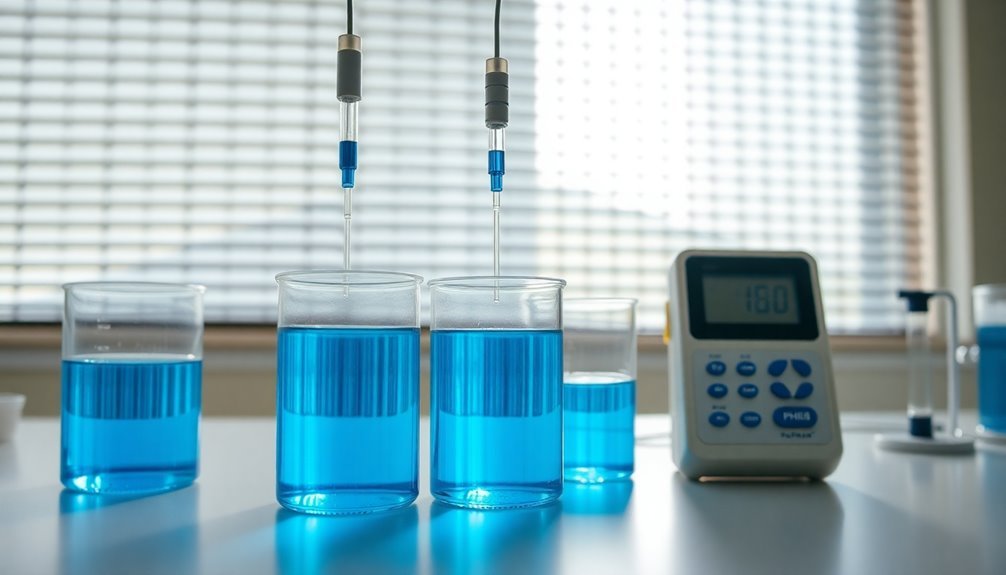
When measuring samples with high ionic strength or elevated target ion concentrations, dilution becomes an essential analytical technique.
You'll find this method particularly useful when analyzing high salt solutions, brine, fluoride in acid baths, or samples with high calcium concentration in seawater. It's also effective for samples with high ionic backgrounds like sulfuric acid or alkaline solutions.
To implement dilution effectively, you'll need to reduce the sample's ionic strength through careful dilution. Add ISA to both your diluted samples and standards according to your ISE User Guide. Before testing, make sure you've calibrated your ISE with appropriate standards. You can then test your diluted sample and compare the measured potential to your calibration curve.
You'll want to pay attention to several key factors when using dilution. Confirm you're using the correct dilution factor to avoid over-diluting your sample, and be mindful of potential contamination during the process.
While the method is relatively straightforward and cost-effective, your results' accuracy depends heavily on precise dilution and proper calibration. The main advantage is that you'll reduce interference from high ionic strength backgrounds while maintaining reliable measurements.
Matrix Match Method Benefits
Matrix matching stands as a powerful analytical technique that delivers exceptional accuracy in ion measurements. You'll find it particularly effective when working with complex samples like food and herbal supplements, where it considerably reduces matrix effects that can interfere with your results.
When you're using matrix matching, you'll achieve better repeatability with relative standard deviations typically staying under 20%. The method improves your recovery rates to above 70% across various matrix types, ensuring you're getting reliable data even with challenging samples. Successful validation studies demonstrate that standard addition methods provide optimal results when combined with matrix matching.
| Benefit | Key Feature | Impact |
|---|---|---|
| Accuracy | Reduces matrix effects | >70% recovery rates |
| Repeatability | <20% RSD | Consistent results |
| Quantitation | Matched calibration | Minimal signal suppression |
While matrix matching requires access to analyte-free blanks and can be challenging when analyzing multiple matrix types, it's often worth the effort. You'll need to prepare calibration standards in a matrix similar to your sample, but this extra step pays off in accuracy. Though isotope dilution might offer slightly higher mean accuracy (97% vs. 85%), matrix matching remains a reliable choice when you're working with complex samples and need consistent, dependable results.
Known Addition Method Explained
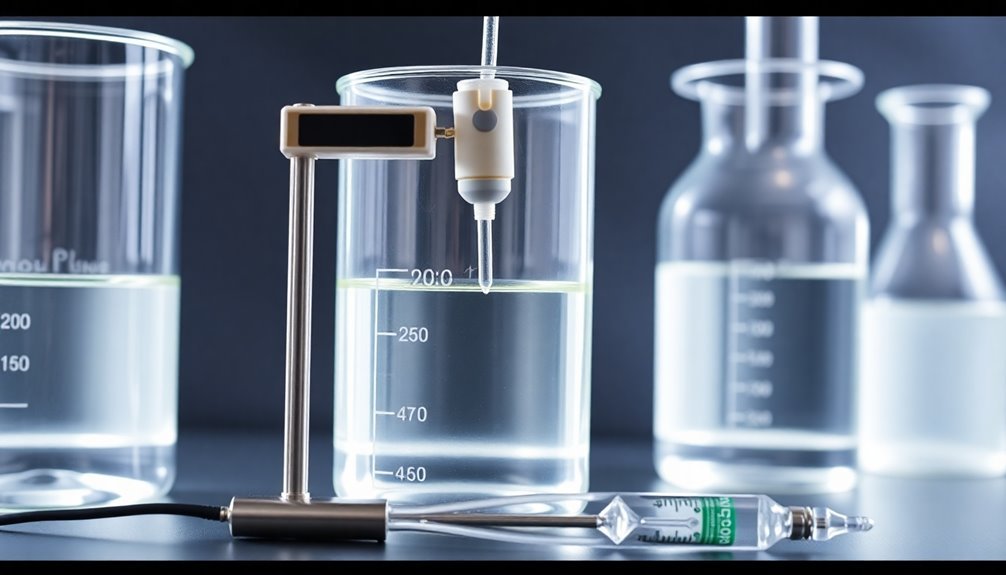
Understanding how the known addition method works can transform your ion measurements from guesswork to precise analysis. This method offers two main approaches: defined volume addition and fixed potential difference addition.
In defined volume addition, you'll add known volumes of standard solution to your sample and measure the potential after each addition. While this approach requires multiple additions, it helps you calculate ion concentrations based on potential differences and volume increments.
The fixed potential difference method provides more reliable results. You'll add standard solution until you reach a predefined potential difference, and modern devices like the OMNIS titrator can automate this process. Remember to keep the total standard volume below 25% of your sample volume.
To guarantee accurate results, you'll need to maintain consistent conditions. Add ISA/TISAB to both samples and standards to keep ionic strength constant, and make sure your samples and standards share the same ionic background.
Always rinse and dry your electrode between measurements to prevent contamination. While this method excels with unknown matrices and interfering ions, it's more time-consuming than direct measurement and requires precise handling of solutions.
Standard Addition Method Overview
The powerhouse standard addition method brings precision to complex ion measurements by adding known increments of standard solution to your sample. You'll find this method particularly useful when you're working with unknown matrices or dealing with interfering ions that might affect your measurements.
| Aspect | Key Point | Benefit |
|---|---|---|
| Process | Add standard solution incrementally | Controls analysis accuracy |
| Volume | Keep additions 10-90% of buret | Guarantees measurement precision |
| Temperature | Maintain consistency | Prevents measurement errors |
| Potential | At least 12mV per addition | Enables accurate calculations |
You'll need to follow specific procedures to get reliable results. Start by pipetting your sample into a beaker, then add ISA/TISAB before making standard solution additions. Don't let your added volume exceed 25% of the sample volume – this helps you avoid dilution errors. The method's real strength lies in its ability to minimize determination errors caused by ionic strength fluctuations and potential drift. You're also getting a cost-effective alternative to expensive techniques like AAS or ICP-OES. When you process your data, you'll use iterative calculations based on potential differences and volume increments to determine the ion concentration accurately.
Selecting The Right Method
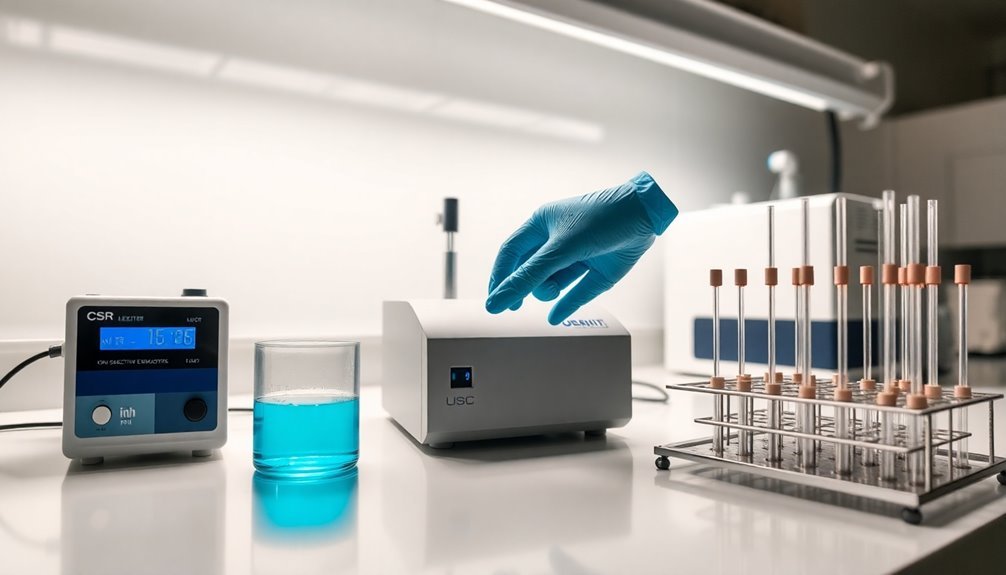
You'll want to start by evaluating your sample's key properties, including its ionic strength, target ion concentration, and potential interferents.
When possible, choose a method that matches your sample's matrix – whether that's the Direct Method for simple aqueous solutions or the Matrix Match Method for complex but consistent samples.
If you're processing many samples, consider balancing method accuracy against practical constraints like time and resources to select the most efficient approach that meets your analytical needs.
Consider Sample Properties First
Successful ion measurement begins with a thorough evaluation of your sample's properties.
You'll need to assess three key aspects: sample type, complexity, and concentration range in order to choose the most suitable method.
For dilute aqueous samples like natural waters or treated wastewater, you can use the Direct Method. However, if you're dealing with high ionic strength samples such as brines or soil extracts, you'll want to opt for the Dilution Method or Matrix Match Method.
When working with food, beverage, or waste samples, the Known Addition Method works best due to their complex matrices.
Your sample's complexity level also dictates method selection. Simple matrices with few interfering substances work well with the Direct Method, while complex matrices require the Known Addition Method to account for interference.
You'll need to take into account concentration ranges too – high concentrations may require dilution, while low concentrations benefit from Matrix Match or Known Addition Methods.
Don't forget to add ISA/TISAB to adjust ionic strength when needed.
Remember to select electrodes with high selectivity for your target ion and prepare standards that match your sample composition for accurate calibration.
Match Matrix When Possible
Selecting the right matrix-matching method starts with understanding your sample's ionic composition and complexity.
When you're dealing with high ionic strength samples that have low target ion concentrations, the Matrix Match Method offers a reliable solution. You'll need to prepare standards that closely mirror your sample's composition, which works particularly well for soil extracts and seawater analysis.
For dilute, aqueous samples like drinking water or treated wastewater, you'll find the Direct Method most efficient. It's quick and accurate, but only when your samples have low ionic strength.
If you're working with high ionic strength samples containing high target ion concentrations, consider the Dilution Method – just make sure you're careful with dilution steps to maintain sample integrity.
When you can't easily match the matrix and have complex samples with low target ion concentrations, the Known Addition Method becomes your best choice.
While it takes longer per test, it's especially valuable for food, beverage, and waste samples with complicated matrices. You won't need a separate calibration curve, and some meters can automate the process, making it reliable for frequent small batch testing.
Balance Speed With Accuracy
Once you've identified the right matrix-matching approach, finding the sweet spot between speed and accuracy becomes your next priority.
You'll need to choose between direct measurement, dilution method, or known addition based on your sample type and accuracy requirements.
While direct measurement offers the quickest results for simple matrices like potable water, it won't deliver reliable data for complex or high ionic strength samples.
- Direct method is fastest but limited to dilute aqueous samples
- Dilution method balances speed and accuracy for high ionic strength samples
- Known addition takes longer but provides superior accuracy for complex matrices
- Standard addition delivers more reliable results than direct measurement
- Matrix matching remains essential regardless of chosen method
For straightforward samples, you can't beat the direct method's simplicity and speed.
However, if you're dealing with high-salt solutions or industrial samples, the dilution method offers a practical compromise.
When accuracy is paramount, especially with complex food, beverage, or waste samples, opt for the known addition method.
Though it requires more time per test, it eliminates the need for separate calibration curves and handles difficult matrices effectively.
Ion Meter Calibration Steps
Properly calibrating your ion meter guarantees reliable and accurate measurements throughout your analysis. To begin, you'll need to prepare calibration standards that match your sample solution's ionic background. Make certain you're using deionized water and maintain the same ratio of ISA/TISAB that you'll use in your actual measurements.
Start your calibration by measuring standards from lowest to highest concentration to minimize carryover effects. You'll need to immerse your ion-selective electrode in each solution after adding the appropriate amount of ISA/TISAB. The electrode will generate an electrical potential corresponding to the ion concentration.
Between measurements, rinse your electrode with deionized water and gently shake off excess moisture. You'll want to verify your calibration every two hours using a fresh portion of your least concentrated standard. Keep a detailed calibration log to track your results and ascertain reproducibility.
If you notice non-reproducible readings, check your standard preparation, electrode handling, and ISA/TISAB addition. Don't hesitate to recalibrate if you suspect any issues with your measurements. Remember to handle your electrode carefully and avoid touching the membrane with your bare fingers.
Sample Preparation Guidelines
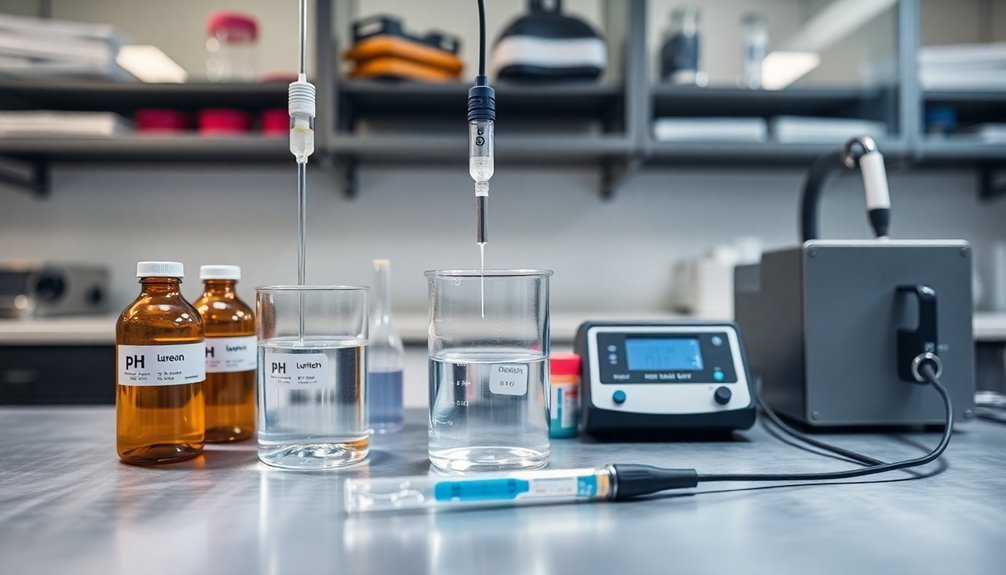
You'll need to add your Ionic Strength Adjustor (ISA) precisely according to your ISE User Guide, ensuring consistent volumes for both samples and standards to maintain measurement accuracy.
When handling complex matrices, you should match your calibration standards to your sample composition or use the known addition method if matrix matching isn't feasible.
For high ionic strength samples, you must either dilute your solution before adding ISA or prepare matrix-matched standards that mirror your sample's composition.
Proper ISA Addition Steps
Successful ion measurements require precise sample preparation steps, including proper ISA (Ionic Strength Adjustor) additions to guarantee accurate results. When you're working with ion analysis, you'll need to follow strict protocols for sample preparation, similar to those used in ion chromatography.
Just as ultrasonic extraction requires specific conditions, ISA addition must be consistent and carefully controlled to ascertain reliable measurements.
- Use ultrapure water for all sample dilutions and preparations to prevent contamination
- Maintain consistent extraction conditions across all your samples to ascertain comparability
- Filter your samples after extraction and before adding ISA to remove any particulates
- Document all steps meticulously, including calibration details and reagent purity
- Validate your results by comparing them with standard reference materials like NIST SRM 1648
You'll need to pay special attention to your calibration standards when adding ISA, as these will directly impact your measurement accuracy.
Remember that quality control measures are essential throughout the process, from initial sample preparation to final analysis. Just as interlaboratory comparisons show variations in certain ion measurements, inconsistent ISA addition can lead to significant differences in results.
Matrix Handling Techniques
After establishing proper ISA protocols, selecting the right matrix handling technique for your samples becomes the next key step in ion measurement.
You'll need to match your sample type with the most appropriate method among four distinct approaches.
For dilute, aqueous samples like potable water or treated wastewater, you'll want to use the Direct Method – it's the quickest and requires no dilution. Just add ISA and test directly.
When dealing with high ionic strength samples that have high target ion concentrations, opt for the Dilution Method. You'll need to dilute your sample before adding ISA.
If you're working with high ionic strength samples that have low target ion concentrations and a known matrix composition, the Matrix Match Method is your best choice. You'll prepare standards that mirror your sample's composition.
For complex samples with low target ion concentrations and difficult-to-match matrices, such as food or beverage samples, use the Known Addition Method. While it takes longer per test, you won't need separate calibration steps.
Remember to verify your calibration standards match your sample's ionic background regardless of which method you choose.
Maintaining Measurement Accuracy
Maintaining consistent accuracy in ion measurements requires diligent attention to several key factors. You'll need to regularly calibrate your ion meters, typically every two hours, to guarantee reliable results. With proper calibration and maintenance, you can achieve accuracy levels of ±0.5% using modern equipment like the SevenExcellence meter.
It's vital to match your calibration standards' ionic background with your sample solution and cover the expected concentration range.
Key practices to maintain measurement accuracy:
- Stir your samples and standards uniformly while avoiding air bubbles that can interfere with readings
- Rinse electrodes with deionized water between measurements, never wiping or rubbing the sensing element
- Verify calibration by testing fresh aliquots of your least concentrated standard
- Add appropriate ionic strength adjusters (ISA/TISAB) to both samples and standards
- Use automated systems when possible to minimize human error
To support these practices, you'll want to maintain detailed data logs and select instruments with multiple channels and customizable options.
Remember that regular maintenance of your electrodes and proper sample handling are essential for achieving consistent, accurate results in your ion measurements.
Troubleshooting Ion Measurement Problems
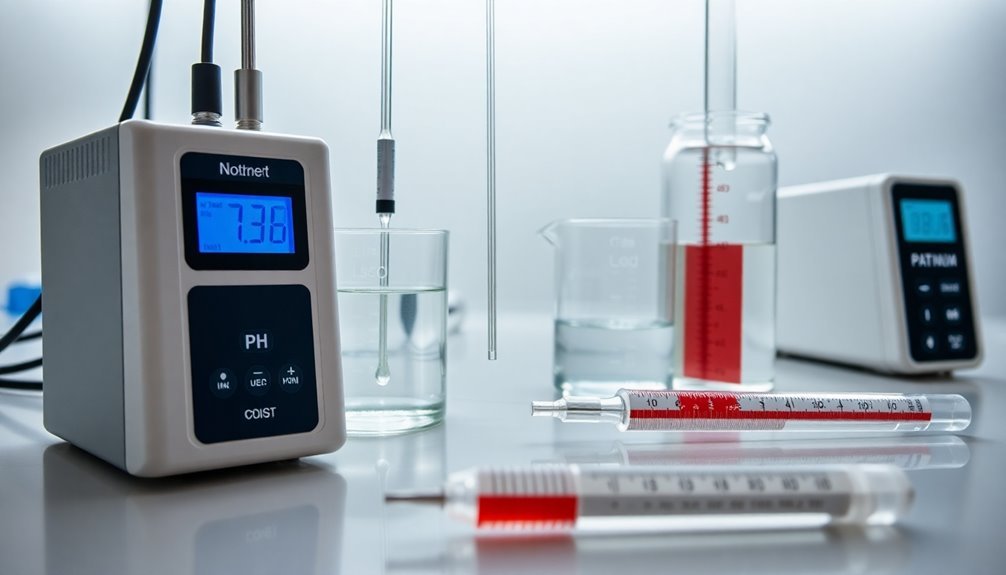
Common ion measurement problems can stem from multiple sources, but you'll find most issues fall into four main categories: sample preparation, calibration errors, electrode maintenance, and method selection.
When dealing with high ionic strength samples, you'll need to adjust your approach. Use ISA solutions to match the sample's ionic background, and prepare standards with similar composition. For complex matrices like soil extracts or brines, consider using matrix match or known addition methods.
Your calibration standards must match the sample's ionic background and cover the expected concentration range. Always measure from lowest to highest concentration to prevent carryover. Regular calibration checks will help maintain accuracy and prevent measurement errors.
Proper electrode care is vital. Rinse with deionized water between measurements, avoid strong vortexing, and verify complete immersion of the reference junction. Poor handling can damage your electrode and compromise results.
Selecting the right method is fundamental. Use the direct method for dilute aqueous samples, dilution method for high ionic strength samples with high target ion concentration, and matrix match or known addition methods for complex matrices with low target ion concentration.
Frequently Asked Questions
How Long Do Ion-Selective Electrodes Typically Last Before Needing Replacement?
You'll typically need to replace your ion-selective electrodes every 6-18 months with frequent use. However, your electrode's lifespan depends heavily on how well you maintain, store, and handle it.
Can Different Measurement Methods Be Combined for Better Accuracy?
Yes, you can combine methods like direct and standard addition or dilution and matrix matching for better accuracy. You'll get more reliable results by using complementary techniques that address different sample complexities and matrix effects.
What Causes Sudden Electrode Drift During Measurements?
Your electrode can drift suddenly due to improper storage, poor cleaning, inadequate calibration, or sample issues. You'll also see drift from temperature changes, contamination, physical damage, or aging electrodes.
How Do Temperature Fluctuations Affect Ion Measurement Results?
Temperature fluctuations will affect your ion measurements by altering electrode response, disrupting calibration stability, and causing non-linear readings. You'll need consistent temperatures between your samples and standards for accurate results.
Are Portable Ion Meters as Accurate as Laboratory-Based Systems?
While portable ion meters offer good accuracy for field work, you'll find they're typically less precise than laboratory-based systems. However, with proper calibration and maintenance, they can provide reliable results for most applications.
In Summary
You'll get the most reliable ion measurements by choosing the right method for your specific application and following proper protocols. Whether you're using direct measurement, known addition, or matrix matching, remember to calibrate your equipment regularly, prepare samples carefully, and maintain clean electrodes. When you encounter issues, systematically check your method, solutions, and equipment to guarantee accurate, reproducible results.

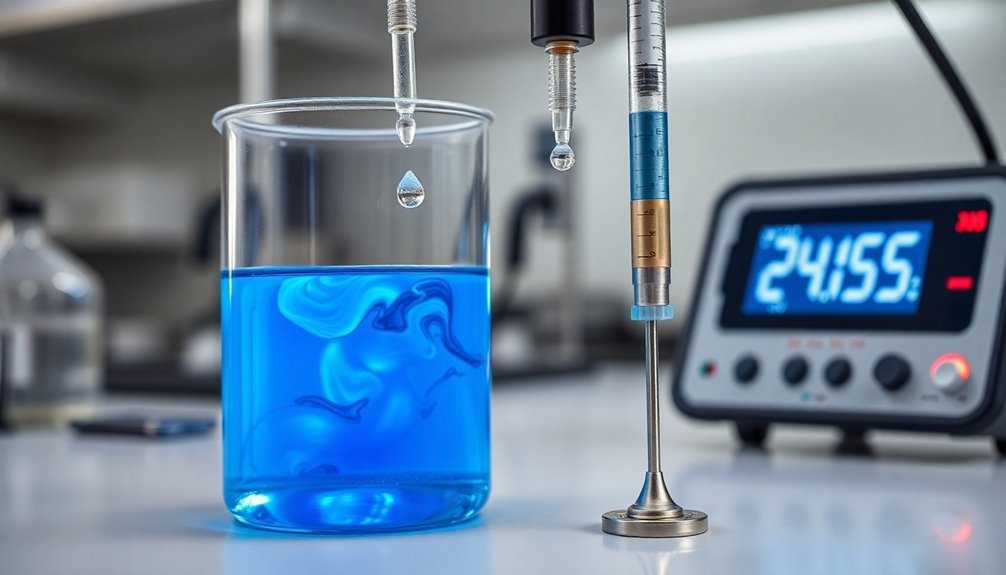



Leave a Reply